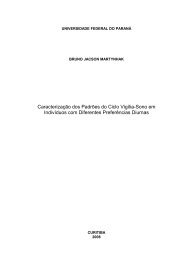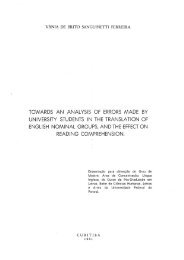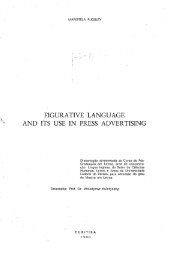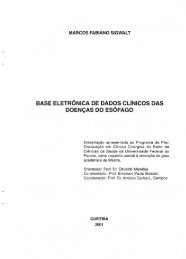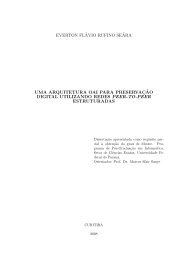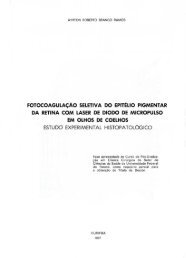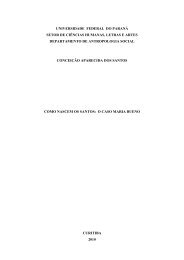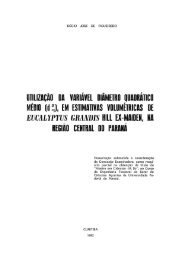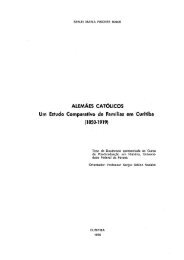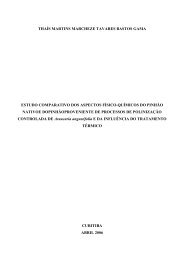- Page 1 and 2: SYLVIO FAUSTO GIL FILHO IGREJA CAT
- Page 3 and 4: SYLVIO FAUSTO GIL FILHO IGREJA CAT
- Page 5 and 6: UNIVERSIDADE FEDERAL DO PARANA SETO
- Page 7 and 8: AGRADECIMENTOS O ato de agradecer n
- Page 9 and 10: " Se desejas uma pérola deves aban
- Page 11 and 12: LISTA DE FIGURAS FIGURA 01 - "O ENT
- Page 13: LISTA DE GRÁFICOS GRÁFICO 01 - N
- Page 17 and 18: desenvolvia. Era o espaço físico
- Page 19 and 20: Ao apresentar e qualificar o sagrad
- Page 21 and 22: dos símbolos, mitos e ritos demons
- Page 23 and 24: Em sua exposição ele declarava qu
- Page 25 and 26: No âmbito da instituição religio
- Page 27 and 28: A representação, portanto, é uma
- Page 29 and 30: • As formas institucionalizadas e
- Page 31 and 32: Na análise de OTTO (1992), o sagra
- Page 33 and 34: Essa experiência é definida pelo
- Page 35 and 36: Religião e Religiões Comparadas.
- Page 37 and 38: que os homens constroem para si." N
- Page 39 and 40: Esta dualidade impregnada no imagin
- Page 41 and 42: eligiões fora do âmbito cristão.
- Page 43 and 44: CAPÍTULO 1 - APROXIMAÇÃO TEÓRIC
- Page 45: eitera: Sobre as organizações rel
- Page 48 and 49: A análise de WEBER não atribui um
- Page 50 and 51: Referendamos o pressuposto de que a
- Page 52 and 53: além das orgulhosas álgebras da c
- Page 54 and 55: Esta oposição imánente à própr
- Page 56 and 57: culturais e diferentes sistemas sim
- Page 58 and 59: A experiência do tempo sob o conte
- Page 60 and 61: 1997): Podemos distinguir três for
- Page 62 and 63: 1.4 - A ESPACIALIDADE DO SAGRADO Gu
- Page 64 and 65:
Somente o clero teria a unção rec
- Page 66 and 67:
Na intenção de demonstrar a dinâ
- Page 68 and 69:
O que observamos no afresco é uma
- Page 70 and 71:
1.5-0 ESPAÇO DE REPRESENTAÇÃO O
- Page 72 and 73:
Já o espaço geométrico abstrai t
- Page 74 and 75:
FIGURA 02 - DIMENSOES DO DEVIR FONT
- Page 76 and 77:
FIGURA 03 - DIMENSOES DA ESPACIALlD
- Page 78 and 79:
LEFÉBVRE (1991, p. 48) entende que
- Page 80 and 81:
FIGURA 04 - CATEGORIAS DA ESPACIALl
- Page 82 and 83:
Consideramos na análise que o fato
- Page 84 and 85:
A noção de espaço de representa
- Page 86 and 87:
FIGURA 05 - REDIMENSIONAMENTO DO ES
- Page 88 and 89:
FIGURA 06 - A TERRITORIALIDADE DO S
- Page 90 and 91:
CAPÍTULO 2 - AS FRONTEIRAS DA TERR
- Page 92 and 93:
QUADRO 03 - TIPOLOGIA DOS DOCUMENTO
- Page 94 and 95:
ORLANDI (1996), na tentativa de def
- Page 96 and 97:
Como afirma BOURDIEU (1996), "a esp
- Page 98 and 99:
Contudo, há uma relativizaçâo do
- Page 100 and 101:
QUADRO 04 - CONCILIOS ECUMÊNICOS C
- Page 102 and 103:
Em 23 de dezembro 1922 o papa Pio X
- Page 104 and 105:
sempre viva e sempre jovem, que sen
- Page 106 and 107:
Assim, este Sagrado Sínodo, alegra
- Page 108 and 109:
2.2.2 - A Fronteira Missionária e
- Page 110 and 111:
(vi) A sexta composição regional
- Page 112:
A posição do decreto Ad Gentes ap
- Page 115 and 116:
CAPÍTULO 3 - AS FRONTEIRAS DO DISC
- Page 117 and 118:
A 2 a Conferência do CELAM, na ava
- Page 119 and 120:
desenvolvimento integral" (Medellí
- Page 121 and 122:
O distanciamento da Igreja no que s
- Page 123 and 124:
O caráter do discurso do CELAM rep
- Page 125 and 126:
No bojo desta reação estava o fat
- Page 127 and 128:
No que tange às relações, só as
- Page 129 and 130:
sua gênese. É subvertido pelas re
- Page 131 and 132:
Além da ambigüidade da identidade
- Page 133 and 134:
Relativo à diocese: "Vive-se a com
- Page 135 and 136:
los Angeles, México, 1979, p. 61).
- Page 137 and 138:
humano, Cristo e Maria, espírito e
- Page 139 and 140:
Na análise de um novo objetivo tra
- Page 141 and 142:
Nesta reflexão temos o cenário qu
- Page 143 and 144:
CAPÍTULO 4 - ESTRUTURAS DA TERRITO
- Page 145 and 146:
da presença do sagrado. O sagrado
- Page 147 and 148:
(ii) O cultural, que emerge das pr
- Page 149 and 150:
As estruturas derivadas representam
- Page 151 and 152:
FIGURA 09 -INSTÂNCIAS DE PODER DA
- Page 153 and 154:
A Reforma do Catolicismo caracteriz
- Page 155 and 156:
GRÁFICO 02 - PROPORÇÃO DA PERTEN
- Page 157 and 158:
Em uma primeira apreensão, as CEBs
- Page 159 and 160:
No bojo do processo de assimilaçã
- Page 162:
Sob o ponto de vista da representa
- Page 166:
O trabalho social de natureza mais
- Page 169 and 170:
O diagnóstico de Dom Valfredo TEPE
- Page 171:
A dinâmica do poder da hierarquia
- Page 175 and 176:
O mesmo autor comenta que se a reli
- Page 177 and 178:
FIGURA 11 - CONCENTRAÇÃO DE PENTE
- Page 179 and 180:
1987/1990, a questão externa relat
- Page 181 and 182:
CAPÍTULO 5 - TERRITORIALIDADE CAT
- Page 183:
No âmbito regional e propriamente
- Page 186 and 187:
Igreja Presbiteriana, a Mesquita e
- Page 189 and 190:
O período de 1970-1996 representa
- Page 191 and 192:
Marchetti Fedalto. Em 28 de feverei
- Page 193 and 194:
40. S.D.S. PADRES SALVATORIANOS - S
- Page 196:
A arquidiocese de Curitiba está, s
- Page 199:
proibição da leitura do evangelho
- Page 203 and 204:
A permanência de uma catolicidade
- Page 206:
Partindo do centro histórico de Cu
- Page 210:
Uma atenção em áreas mais rentá
- Page 213 and 214:
Os sacramentos são instrumentos si
- Page 217 and 218:
A ASSINTEC congregava denominaçõe
- Page 219 and 220:
CONCLUSÃO A construção desta tes
- Page 221 and 222:
Em conseqüência desta nova trama,
- Page 223 and 224:
(vii) A fragmentação territorial
- Page 225 and 226:
deste processo de fracionamento do
- Page 227 and 228:
Questionário Estatítico Geral Anu
- Page 229 and 230:
III - DOCUMENTOS EPISCOPAIS DO CONS
- Page 231 and 232:
.Carta aos Agentes de Pastoral e à
- Page 233 and 234:
PAULO IV. Carta Encíclica Ecclesia
- Page 235 and 236:
Evolução do Contigente Prebiteria
- Page 237 and 238:
VIII - FONTES DA ASSOCIAÇÃO INTER
- Page 239 and 240:
BARRET, D. B. World Christian Encyc
- Page 241 and 242:
CHURRUCA, A.; GUTIERREZ, G. & outro
- Page 243 and 244:
HALL, S. A Identidade Cultural na P
- Page 245 and 246:
. Social Representations - Explorat
- Page 247:
UNIVERSIDADE FEDERAL DO PARANÁ- SI



